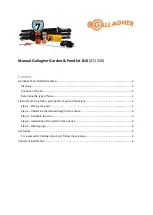
Chapter 8: Measurement of Small Signals--Measurement System Model and Physical Limitations
8 - 4
Voltage Noise and DC Measurements
Often the current signal measured by a potentiostat shows noise that is not the fault of the current-
measurement circuits. This is especially true when you are making DC measurements. The cause of the
current noise is noise in the voltage applied to the cell.
Assume that you have a working electrode with a capacitance of 40 µF. This could represent a 1 cm
2
polished bare metal immersed in an electrolyte solution. You can roughly estimate the capacitance of the
electrical double-layer formed by a metal/electrolyte interface as 20 µF/cm
2
. The area is the microscopic
area of the surface, which is larger than the geometric area, because even a polished surface is rough. The
impedance of this 40 µF electrode, assuming ideal capacitive behavior, is given by:
Z
= 1/
j
C
At 60 Hz, the magnitude of the impedance is about 66 Ω.
Apply an ideal DC potential across this ideal capacitor and you get no DC current.
Unfortunately, all potentiostats have noise in the applied voltage. This noise comes from the instrument
itself and from external sources. In many cases, the predominant noise frequency is the AC power-line
frequency.
Assume a realistic noise voltage,
V
n
, of 10 µV (this is lower than the noise level of most commercial
potentiostats). Further, assume that this noise voltage is at the US power-line frequency of 60 Hz. It will
create a current across the cell capacitance:
I
=
V
n
/
Z
10 × 10
−6
/66
150 nA
This rather large noise current prevents accurate DC-current measurement in the low nA or pA ranges.
In an EIS measurement, you apply an AC excitation voltage that is much bigger than the typical noise
voltage, so this is not a factor.
Shunt Resistance and Capacitance
Non-ideal shunt resistance and capacitance arise in both the cell and the potentiostat. Both can cause
significant measurement errors.
Parallel metal surfaces form a capacitor. The capacitance rises as the area of the metal increases and as the
separation between the metal surfaces decreases.
Placement of the wires and electrodes has a large effect on shunt capacitance. If the clip leads connecting
to the working and reference electrodes are close together, they can form a significant shunt capacitor:
values of 1 to 10 pF are common. This shunt capacitance cannot be distinguished from “real” capacitance
in the cell. If you are measuring a paint film with a 100 pF capacitance, 5 pF of shunt capacitance is a very
significant error.
Shunt resistance in the cell arises because of imperfect insulators. No material is a perfect insulator (one
with infinite resistance). Even Teflon
®
, which is one of the best insulators known, has a bulk resistivity of
about 10
12
Ω
∙
m. Worse yet, surface contamination often lowers the effective resistivity of good insulators.
Residual water films can be a real problem, especially on glass.
Shunt capacitance and resistance also occur in the potentiostat itself. Specifications for the Interface 1000
in Potentiostat Mode, in Appendix A, contain equivalent values for the potentiostat’s
R
shunt
and
C
shunt
. These
values can be measured by an impedance measurement with no cell.
In most cases, the cell’s shunt resistance and capacitance errors are larger than those from the potentiostat.
Содержание Interface 1000
Страница 8: ......
Страница 18: ......
Страница 36: ...Chapter 4 Cell Connections Membrane Cell Connections 4 4...
Страница 44: ...Chapter 5 Panel Indicators and Connectors Rear Panel 5 8...
Страница 62: ...Chapter 8 Measurement of Small Signals Floating Operation 8 8...
Страница 68: ...Appendix A Interface 1000 Specifications Floating Operation Appendix A 6...
Страница 70: ...Appendix B Interface 1000 Cell Connector Floating Operation Appendix B 2...
Страница 78: ...Appendix E CE Certificate Appendix E 2 Low Voltage Certificate of Conformance...
Страница 79: ...Appendix E CE Certificate Appendix E 3 RFI Certificate of Conformance...
Страница 80: ...Appendix E CE Certificate Appendix E 4...
Страница 84: ...Appendix F Heat in Interface 1000 MultEchem Systems Appendix F 4...















































